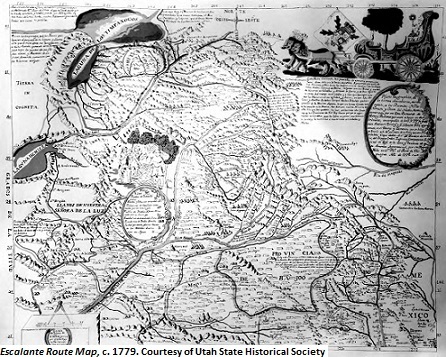Dublin Core
Title
Description
In 1776, the same year the Declaration of Independence was signed, a group of Spanish explorers entered present-day Utah Valley. Led by two Franciscan friars named Silvestre Velez de Escalante and Francisco Dominguez, the expedition was launched to find a northern path from New Mexico to one of Spain's newest colonies, California.
Dominguez and Escalante left Santa Fe in July, traveling north. By the time they reached what is now Colorado, they'd recruited 12 other Spaniards and two Ute men, members of the Timpanogots band that lived on the shores of Utah Lake, to join them. The two Native Americans agreed to guide the Spanish to Utah Valley. Their trail from Colorado took them near what is now Dinosaur National Park, up the Strawberry River, and down Spanish Fork Canyon. On September 23, they climbed a hill near the present-day Spanish Oaks Golf Course, and were treated to a panoramic view of the pristine valley below them, with its sparkling emerald lake and ring of steep mountains. Intending to push on to California, the Spaniards recruited a new Timpanogos guide and turned southwest. But their guide didn't stick around for long and by October they were marching through snow, so they revised their plans and headed back to New Mexico.
The Dominguez-Escalante expedition illuminates the competing claims people made to the land we now know as Utah. The territory remained on the fringes of the Spanish Empire even after word of the expedition got out. Occasional trading, trapping, and slaving expeditions made their way through the region, but few if any Spaniards chose to settle here. Still, the Spanish and the Mexicans—who won independence from Spain in 1821—claimed the area as theirs. The Treaty of Guadalupe Hidalgo, which ended the war between the United States and Mexico in 1848, legally turned the region over to the American government, but older traditions and claims still remain. When Mexican immigrants talk about crossing the border into the United States, they often don't refer to the name of the nation they're moving into. Instead they call the land "El Norte"—the North—or the piece of the American West that was once part of the old Spanish and Mexican empires.
Creator
Source
Image: Escalante Route Map, c. 1779. Cartographer: Bernardo de Miera y Pacheco. Map titled: "Plano geografico de la tierra descubierta y demarcada por Dn. Bernardo de Miera y Paceco al Yumbo del noroeste y oest del Nuevo Mexico, quien fue en compania de los R.R.s P.Ps. Fs. Fran.co Atanacio Dominguez... y Fr. Silvestre Velez de Escalante..." Courtesy of Utah State Historical Society.
_______________
See Thomas G. Alexander, Utah: The Right Place 2d ed. (Salt Lake City: Gibbs Smith, 2003), 55-57; and Ted J. Warner, The Dominguez-Escalante Journal: Their Expedition Through Colorado, Utah, Arizona, and New Mexico in 1776 (Salt Lake City: University of Utah Press, 1995). Also see Bernice M. Mooney’s entry on the Catholic Church in the online Utah History Encyclopedia at www.media.utah.edu/UHE.

